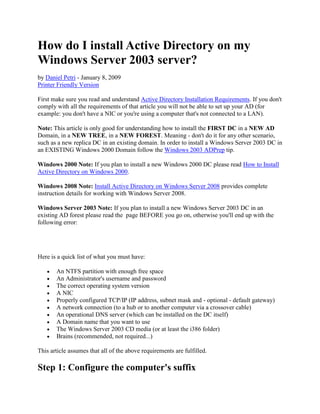The document provides instructions for installing Active Directory on a Windows Server 2003 server in 3 main steps:
1. Configure the server's TCP/IP settings and DNS zone to point to itself as the DNS server.
2. Run Dcpromo.exe to promote the server to a domain controller for a new domain and forest.
3. Check that the Active Directory installation was successful by verifying tools, sites, and required files and shares.





![that is highest in the list gets the first try, and if it does not respond within a given time
limit - the query will be forwarded to the next server in the list.
5. Click OK.
Creating a Standard Primary Reverse Lookup Zone
You can (but you don't have to) also create a reverse lookup zone on your DNS server. The
zone's name will be the same as your TCP/IP Network ID. For example, if your IP address is
192.168.0.200, then the zone's name will be 192.168.0 (DNS will append a long name to it, don't
worry about it). You should also configure the new zone to accept dynamic updates. I guess you
can do it on your own by now, can't you?
Step 4: Running DCPROMO
After completing all the previous steps (remember you didn't have to do them) and after double
checking your requirements you should now run Dcpromo.exe from the Run command.
1. Click Start, point to Run and type "dcpromo".
2. The wizard windows will appear. Click Next.
FREE eBook (Draft Preview): Microsoft SQL Server Code Name “Denali”
[PDF]](https://image.slidesharecdn.com/1-130518004635-phpapp02/85/1-6-320.jpg)




